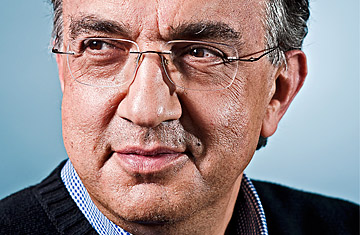
Sergio Marchionn at Chrysler headquarters in Auburn Hills, Mich.
(5 of 7)
With Chrysler, there was no financial risk, since he was playing with (White) house money. Absent economic chaos, Chrysler had a good chance of reviving for one simple reason: people need cars and trucks. In 2009 only 10.4 million vehicles were sold in the U.S., down 35% from the 16 million sold in 2007. Yet given the automobile scrappage rate, about 5% annually, the U.S. needs something on the order on 11 million to 13 million new vehicles just to keep people on the road.
Even though people held on to their cars longer in 2008 and 2009, demand had to recover; it was only the rate of recovery that was in question. "We knew instinctively that the recovery was going to be a lot slower than people had hoped it would be," says Marchionne. "So we retooled this house to deal with a market which is not exciting, where you've really got to fight a lot harder than you would in a market that's growing back at 10-plus percent a year."
Chrysler faced what he calls execution risk: Can I do what I set out to do? If the company could build decent products, there would almost certainly be a market for them. "Once it's execution, then you've got to look into your shorts and you've got to say to yourself, Do you actually have--do you--I mean I, as a person, do you have the wherewithal to get this done?"
In a move that signaled where his heart is, earlier this year Marchionne became CEO of Chrysler Group. His office is on the fourth floor in the engineering department, not the executive penthouse, now sitting empty, where a chairman and three vice chairmen used to rule. "I don't have an office of the chairman. Which is what used to run this joint," he says, quickly adding, "with all due respect." And implying all due disdain. He spends half his time in the U.S., although he technically still resides in Switzerland.
Now for the Hard Part
The revamped Chrysler has proved it can make cars, minivans and trucks that people will buy. But that has only bought time for the company. Now it has to prove it can make vehicles people will love. Next year the sales comparisons won't be so easy, and Japanese rivals like Toyota, which suffered supply shortages because of Japan's earthquake, will be at full output. Chrysler plans to launch eight new models next year, beginning with a new Dodge compact based on Fiat's Alfa Romeo Giulietta platform. "We were lean on product and really needed to survive the second half of '09 and pretty much all of 2010, which we did," says Reid Bigland, head of the Dodge brand and Chrysler Canada. "Now the cavalry of product is coming."
Chrysler is repositioning its brands too, so that each stands for something unique and cars and messages don't overlap. Dodge becomes a lifestyle brand, from muscle cars with attitude, like the Viper, to fun crossovers like the Journey. Ram is pickups and other trucks, and perhaps Fiat-made, Ram-branded vans. Chrysler is style and a little luxury and will eventually own all things minivan. Jeep is king of the off-road and SUVs. Fiat's return to the U.S. market gives dealers a small-car brand with European flair. Alfa Romeo will also be reintroduced via Fiat dealers. "When you put the two organizations together," says Bigland, "it's the perfect Fiat." Forgive him, he's a car salesman.
